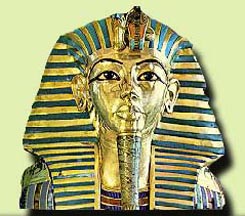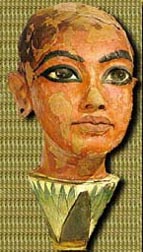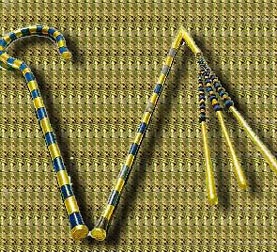.
Tutankhamen's
Treasures

| The funeral mask
of Tutankhamun was made in the traditional form of the god Osiris. The
Egyptians believed that by enacting magical burial rites his body would
be reanimated as Osiris had. This mask was made of gold with glass eyes
and lapis lazuli eyebrows and eyelashes. The manner of painting the eyes
is also identified with the sun god. |
Though small and unimpressive, Tutankhamun's Tomb is probably the
most famous, due to its late discovery. Howard Carter's description
upon opening the tomb in 1922 was, "At first I could see nothing,
the hot air escaping from the chamber causing the candle flames
to flicker, but presently, as my eyes grew accustomed to the light,
details of the room within emerged slowly from the mist, strange
animals, statues and gold - everywhere the glint of gold. For the
moment - an eternity it must have seemed to the others standing
by - I was dumb with amazement, and when Lord Carnarvon, unable
to stand the suspense any longer, inquired anxiously, 'Can you see
anything?' it was all I could do to get out the words, "Yes, wonderful
things."
|

This
plaster head is a true likeness of the young king. He is pictured
emerging from the lotus flower, just as the sungod Osiris had done
when he came into existence from a lotus flower on the surface of
the ocean at the creation of the universe.
|
This necklace, which resides in the
Cairo Museum, represents the right eye of Re, the principle of light;
the eye is framed by Uadjit the serpent, of the north, and Nekhebit,
the vulture, of the south. This piece of jewelry was found inKing
Tut's tomb, and was probably worn for ceremonial purposes.
|
This coffin, made of solid gold, represents
Tutankhamun as the god Osiris golding his regular emblems, the crook
and flail, but with the features of the king himself. It is over six
feet in length and about one eighth of an inch in thickness.
|
This Pectoral, belonging to Tutankhamun,
represents the goddess Nekhbet, in the shape of a vulture, holding
to shenu-signs in her talons. This protective amulet was found on
the mummy of the king.
|
Tutankhamen's funeral bed is made in
the bovine form of the goddess Hathor with the solar disc between
her horns. This is the bed on which Tutankhamen's coffin was layed.
|

The Crook And Flail, the emblems of Osiris,
were carried by kings on some ceremonial occasions. The flail may
have been used in Tutankhamun's coronation since it has the cartouche
of both his childhood name and the name he took as king, Nebkheperura.
|

This royal scepter is made of wood with a sheet
of gold beaten to it. On the side of the blade there is an inscription reading
"The good god, the beloved, dazzling of face like the Aton when it shines,
the son of Amun, Nebkheperura, living for ever." Above the inscription is
a frieze of lotus petals, and on the other side of the blade are rows of trussed
and slaughtered bulls.
This tabernacle contains the king's
internal organs. It is made of gold plated wood, includes small coffins
for each of the organs, and is flanked on all four of its sides by
protective gods.
|
The golden throne was used for meetings
of state. Made of wood and overlaid with sheet gold, its lion-paw
legs are covered with either copper or bronze. The decorationis an
image of Tutankhamen and his wife.
|
The small chair (only 141Ú2" wide)
was used by Tutankhamen as a child. The wood is ebony, inlaid with
ivory and the joints are riveted with either copper or bronze pins
capped with gold.
|
This cobra is identified as Netjer-ankh,
or "the living god." It is made of gilded wood, and was found in one
of the black shrines, which contained figures of underworld spirits.
|
This carved lions-head was found on
one of the beds in Tut's tomb. Its features are the same as those
of Sekhmet, a lioness goddess. It is made of carved wood, gilded in
gold, with colored glass nose and eyes.
|
This Shrine is made of wood and overlaid
with sheet gold. It is an architectural model of the ancient shrine
of the vulture goddess Nekhbet of the north, known as the Great House.
|
Back to Ancient Egypt
|